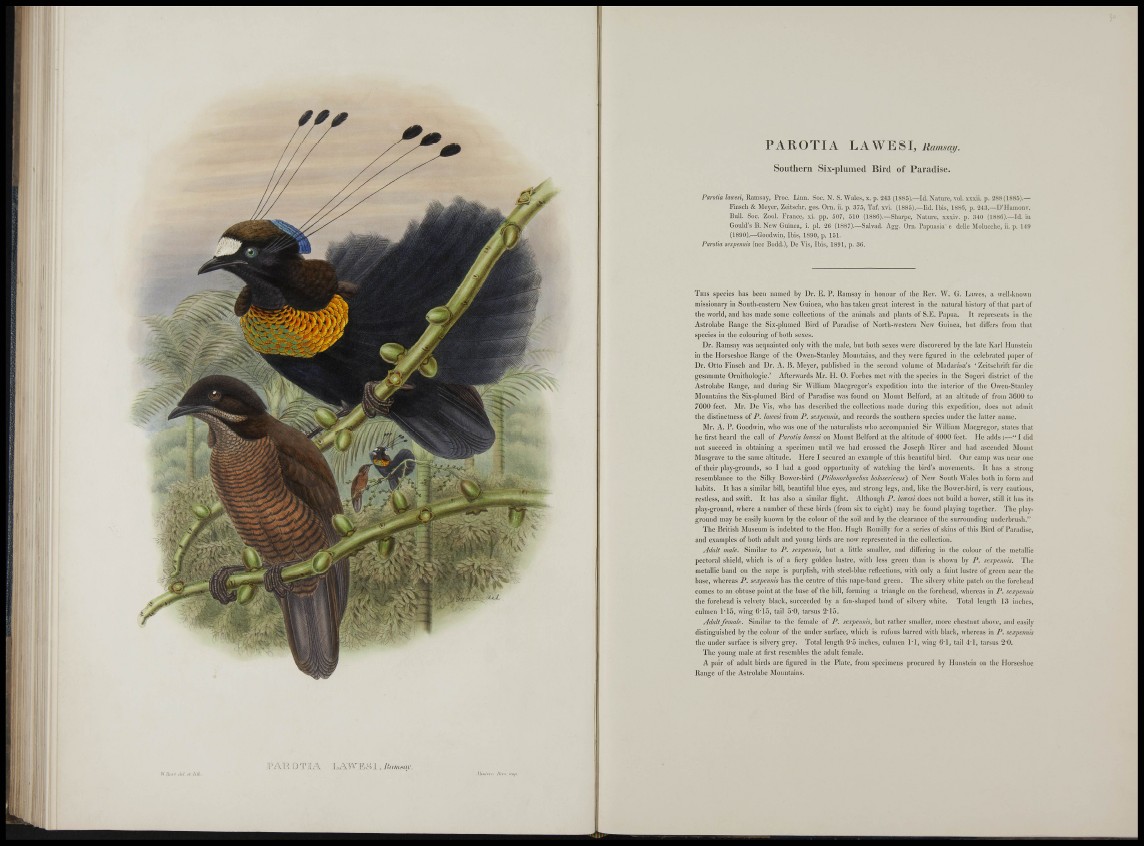
¡ÌT.'.Ì ! 1
a" m
rf'i
••; I
li,' M'if :
-in:
T
W'U.oi .M .7 l,ll> .\l„.l.r,. Ihr.' -^VJ
fi •
ì':
111'.
P A R O T I A LAWESI, Ramsa>y.
Southern Six-plumed Bird of Paradise.
Paratia lawesi, Ramsay, Proc. Linn. Soc. N. S. Wales, x. p. 243 (1885).—Id. Nature, voi. xxxii. p. 288 (1885).—
Fiasch & Meyer, Zeitschr. ges. Oi'n. ii. p. 37S, Taf. xvi. (1885).—liei. Ibis, 1880, p. 243,—D'IIamoiiv.
Bull. Soc. Zool. France, xi. pp. 507, 510 (1886).—Sharpe, Nature, xxxiv. p. ;i40 (1880).—1(1. iu
Gould's B. New Guinea, i. pi. 26 (18S7).—Salvad. Agg. Orn. Fapuasia e delle Molucche, ii. p. 14!)
(1890).—Goodwin, Ibis, 1890, p. 151.
ParoUa sexpennis (nec Bodd.), De Vis, Ibis, 1891, p. 30.
THIS species has been named by Dr. E. P. Ramsay in honour of tiie Rev. W. G. Lawes, a well-known
missionary in South-eastern New Guinea, who has taken great interest in the luitural history of that part of
the world, and has made some collections of the animals and plants of S.E. Papna. It rejiresents in the
Astrolabe Range tiie Six-phiincd Bird of Paradise of North-western New Guinea, but diilers from that
species in the colouring of both se.xes.
Dr. Ramsay was acquainted only with the male, but botii sexes were discovered by the lale Karl Huiistein
in the Horseshoe Range of the Owen-Stanley Mountains, and they were figured in the celebrated paper of
Dr. Otto Fiusch and Dr. A. B. Meyer, published ii] the second volume of Madarasz's ' Zeitschrift für die
gesammte Ornithologie.' Afterwards Mr. H. 0 . Forbes met with the s])ecies in the Sogeri district of the
Astrolabe Range, and during Sir AVilliam Macgregor's ex|)e(lition into tlie interior of tiie Owen-Stanley
Mountains tlie Six-plumed Bird of Paradise was found on Mount Belford, at an altitude of from 3C00 to
7000 feet. Mr. De Vis, who has described the collections made during this expedition, docs not admit
the distinctness of P. laicesl from P. sexpennls, and records the southern species under the latter name.
Mr. A. P. Goodwin, who was one of the naturalists who accoin|)anied Sir William Macgregor, states that
he first heard the call of Parotia lawesi on Mount Belford at the altitude of 4000 feet. He adds :—" I did
not succeed in obtaining a specimen initil we had crossed the Joseph River and had ascended Mount
Musgrave to the same altitude. Here I secured an example of this beautiful bird. Our cam]i was near one
of their play-grounds, so I had a good opportunity of watching the bird's movements. It has a strong
resemblance to the Silky Bower-bird (JPtilonor/Lijncluis koiosericeus) of New South AVales both in form and
habits. It has a similar bill, beautiful blue eyes, ami strong legs, and, like the Bower-bird, is very cautious,
restless, and swift. It has also a similar (light. Although P. lawesi does not build a bower, still it has its
play-ground, where a number of these birds (from six to eight) may be found jdayitig together. The j)layground
may be easily known by the colour of the soil and by the clearance of the surrounding uiiderbrush."
The British Museum is indebted to the Hon. Hugh Romilly for a series of skins of this Bird of Paradise,
aiul examples of both adult and young birds are now represented in the collection.
Adult male. Similar to P. se^vpemns, but a little smaller, and differing in the colour of the metallic
pectoral shield, which is of a fiery golden lustre, with less green than is shown by P. sexpentiis. The
metallic band on the [lape is purplish, with steel-blue reflections, with only a faint lustre of green near the
base, whereas P. sexpennis has the centre of this najie-baud green. The silvery white patch on the forehead
comes to au obtuse jjoint at the base of the bill, forming a triangle on the forehead, whereas in P. sexpemiis
the forehead is velvety black, succeeded by a fan-shaped band of silvery white. Total length 1,3 inches,
culmcn I-I5, wing G'lS, tail S'O, tarsus ^-IS.
Adult female. Similar to the female of P. sexpemiis, but rather smaller, more chestnut above, and easily
distinguished by the colour of the under surface, which is rufous barred with black, whereas iu P. sexpenjiis
the under surface is silvery grey. Total length 9"0 inches, culnien I'l, wing G'l, tail 4-1, tarsus '2"0.
The young male at first resembles the adult female.
A pair of adult birds are figured in the Plate, from specimens procuj-ed by Hunstein on tlie Horseshoe
Range of the Astrolabe Mountains.